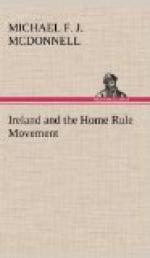The system of tenure in Ireland was as different as possible from that existing in Great Britain. The gist of the difference lay in this, that in England and Scotland landlords let farms, while in Ireland they let land. “In Ireland,” wrote an English observer more than a hundred years ago, “landlords never erect buildings on their property, nor expend anything in repairs.” This feature, which was the result of historical reasons, was due to the fact that Irish land-owners were the descendants of settlers intruded on Irish land, who brought with them English notions of tenure, but had not the capital to render economic the numerous small holdings situated on their estates. Hence it came about that the provision of capital by an English landlord for the equipment of farms with cottages, outhouses, fencing, and a drainage system, which results in a sort of partnership between landlord and tenant, was, to a large extent, a thing unknown in Ireland, where, as was aptly said, tenants’ improvements were landlords’ perquisites, and where point was lent to the differences by the fact that the few properties on which the equipment of the holdings was provided by the landlord were known as “English-managed estates,” and the number of these, Lord Cowper told the House of Lords in 1887, could be counted on one’s fingers.
Irish landlords have been compared, not to English squires, but to the ground landlords of London, bound to the occupiers only in so far as they received from their tenants a rent-charge liable to increase as the tenant improved the holding, or as competition arose with the growth of population.
The reasons for this state of things are to be found in the number and the small size of the Irish holdings, but more than this in the fact that from the first landlords came there in a business capacity.
“Les uns comme les autres,” says a French writer, M. Paul-Dubois, “ils n’ont vu dans la terre Irlandaise qu’une affaire, et non une patrie. Ils sont restes conquerants en pays de conquete. De la cette consequence que, conscients d’etre des etrangers, des intrus, ils se sont crus libres et quittes de toute dette envers le pays, de tous les devoirs de la propriete."[3]
Planted on land which was confiscated, and, as a result, insecurely held, to risk the expenditure of money would have been unnatural, the more so since the expenditure which, in the circumstances, fell upon the tenant in the matter of improvements, provided the best possible security to the landlord by making the tenant all the more anxious to remain on the holding on which he had sunk what little capital he possessed, and in consequence virtually obliged, at risk of ejection, to submit unwillingly to periodical enhancements of rent.




